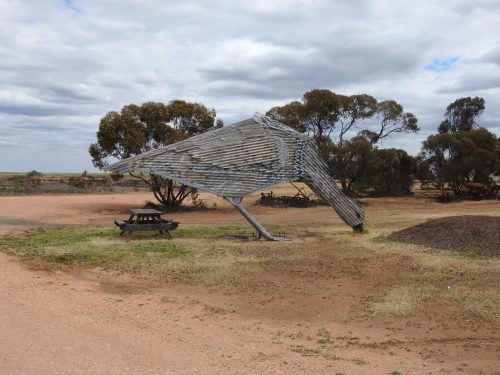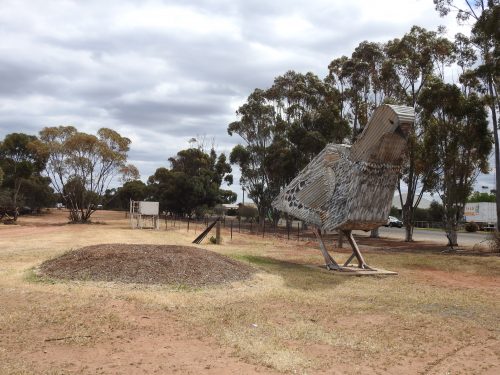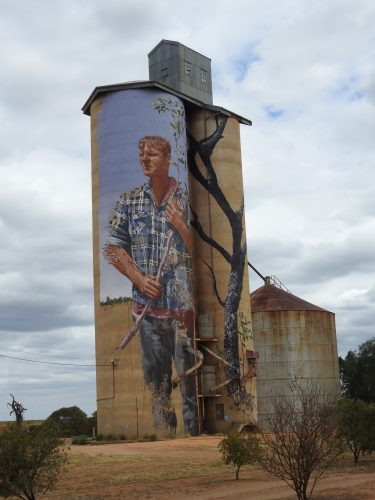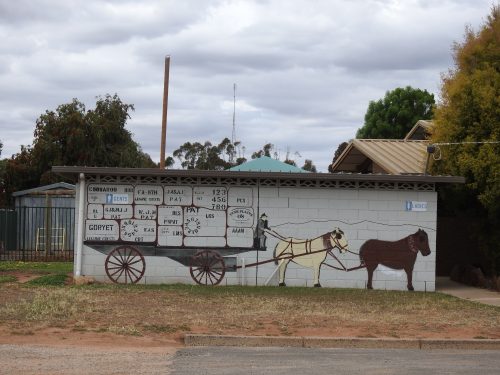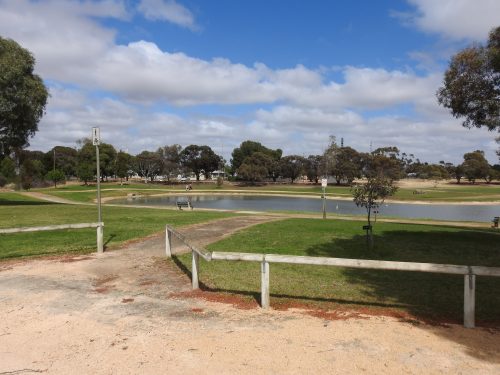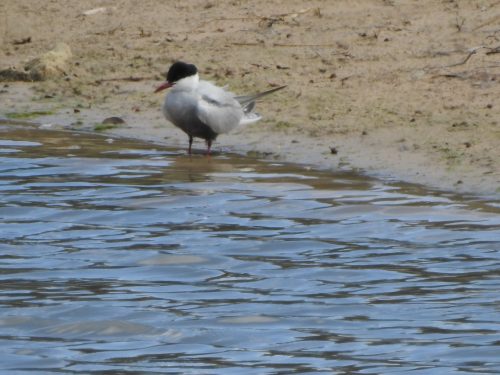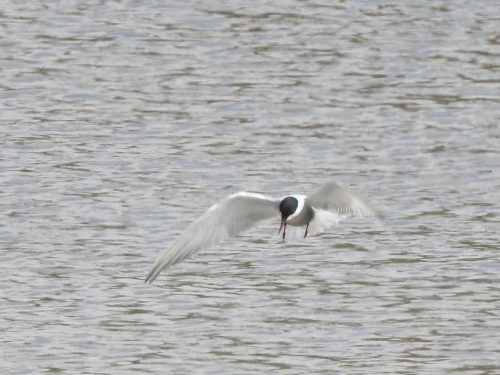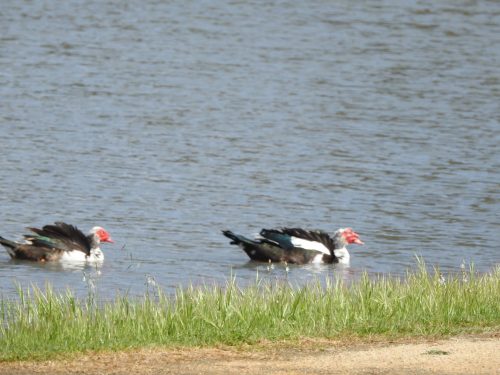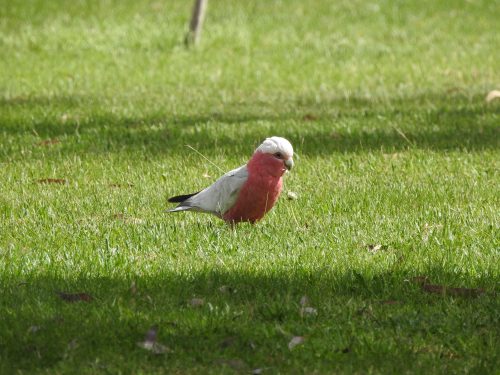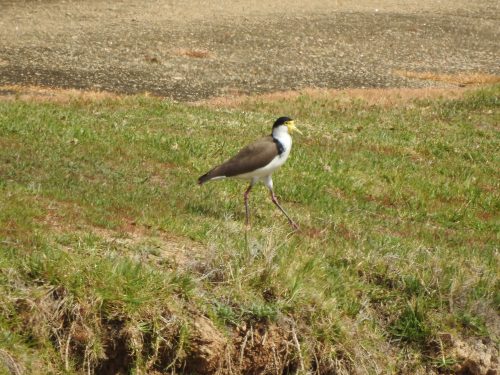What a big Mallee Fowl
Patchewollock
On my way to Sydney last week I took a slight detour to the small town of Patchewollock in the north-western part of Victoria. This small farming community is mostly based on wheat growing as well as sheep for wool. In the 2016 census, the population was 133, down from 350 in 2011, so it is a town which is struggling to survive. It still has a post office, a pub and a general store. When I drove around the town for a few minutes I drove past the school. Sadly, this closed a decade ago, so the children now go to school elsewhere by bus. This is a familiar story in the rural districts throughout Australia. One thing the locals are trying to do to increase visitors to the town is their annual Music Festival. It was being set up during my visit and I missed it by a few days. You can read more about Patchewollock here.
Mallee Fowl sculptures in Patchewollock
One of the reasons for visiting this town was the possibility of seeing a Mallee Fowl. From time to time this elusive species can be seen crossing roads in the area. A few years ago there were reports of dozens being sighted on the Walpeup to Patchewollock road. This time I missed out entirely – but I was able to take photos of the very large Mallee Fowl sculptures shown above and below.
The sculptures are made from corrugated iron, a material very common on Australian farms. Many urban homes and sheds are also covered using this material. From the photo above you can gauge the scale of each construction. The picnic table on the left shows that each bird must be at least 4 – 5 metres high, quite a bit taller than the real bird which stands at 55 – 60 cm (2 foot) high.
Ironically, the nesting mound shown in the photo below is not far off the dimensions of the real thing. I have seen nesting mounds up to 4 – 5 metres in diameter and 1 metre high. The male tends the nesting mound for many months, scraping sticks, leaves and grass into the mound which acts like a compost heap, the heat produced hatching the eggs inside. You can read more about the so-called ‘incubator bird” here.
Silo Art Work
Until I arrived in Patchewollock, I hadn’t realised that this little town boasted one of the now popular grain silo artworks. In the photo below you can see the portrait of one of the local farmers featured on the grain silo in the railway yards. This larger than life artwork is now featured on many grain silos across the rural areas of Australia, especially in Victoria and South Australia, but I have heard recently that several have been painted in Western Australia too. There are now enough in this area of Victoria to make a tour of these amazing art installations. For more information click here. It is obviously becoming very popular with tourists. When I visited, there were at least six other vehicles near me, the occupants also taking photos. More cars were near the store. This tourist attraction can only help to boost the future hopes of this small town, and others like it.
Artwork on Public Toilets
My final photo for today’s post is of the humble public toilets near the town’s store. This building also boats some artwork, albeit on a much smaller and humble scale. This reflects the town’s pride in its historic farming heritage. This kind of artwork is becoming common in many parts of rural Australia and I applaud this recognition of the past.
Back on the road again
It has been a while.
It has been far too long since I last posted an article here on this site. It has not been an easy year for me so far (read here to find out why). But now I am back and keen to post many more bird photos here, as well as relate some highlights of my travels and birding experiences.
A special birthday
Last week my family celebrated my grandson’s 10th birthday, so I just had to come over from South Australia to Sydney for the occasion. It’s a 14 hour, two-day drive so it is not a trivial undertaking. This was my first big trip by myself, so I decided to take three days and take it easy. I am pleased that I did because I saw a few birding highlights along the way. More of that in coming posts.
The birthday party was held in a park near my son’s home and it was very successful – despite the rain trying to spoil it. The invited guests were determined to have a good time, and they did not to let the rain spoil their fun. It was a huge success and the food was also great. Love party food.
Lake Roberts, Lameroo
When I left home in Murray Bridge last week, my first stop was at Lake Roberts on the edge of Lameroo, a small farming based community in the eastern part of South Australia. I stopped for a break and a cup of tea. As I was having my morning tea, I made a list of the birds seen and heard. I also grabbed my camera and took a few photos. The photo above is a general shot of the artificial lake. Behind me is a small caravan park and to my left is a picnic area with tables seats covered by a roof.
Bird list
My bird list for the twenty-minute stay is not long, nor is it exciting – except for one bird.
Galah
Australian Magpie (both white-backed and black-backed)
Welcome Swallow
Singing Honeyeater
Red Wattlebird
Willie Wagtail
Crested Pigeon
Magpie-lark
Whiskered Tern
It is the last species which grabbed my attention.
I have visited this spot on many occasions on my trips to and from Sydney. This is the first time I have recorded a Whiskered Tern in this spot, and although it is a widespread species throughout much of Australia, it was an unexpected extra on this occasion. The photos are not great, unfortunately. Many of the photos were taken at extreme zoom, and are therefore not great.
The shot above is the one occasion that the solitary bird came to rest on the small beach along the edge of the lake. For the rest of the time, it kept flying around the perimeter of the small lake, diving into the water every ten seconds or so. I am not sure what it caught to eat, but it was quite persistent in this behaviour for most of the time I watched it. One of the better photos of it flying is shown below.
(Note to self: try to master photographing birds in flight.)
Other species
I didn’t have much time to photograph all of the other species present on this visit. I have shown some of them below. One species not listed above is the Muscovy Duck. This is a feral bird found in a few places around Australia, usually near farmhouses, dams and artificial lakes and ponds. It is native to Mexico, Central and South America. Feral populations exist in many countries, mainly as a result of releases by people or escapes from farms and gardens.
